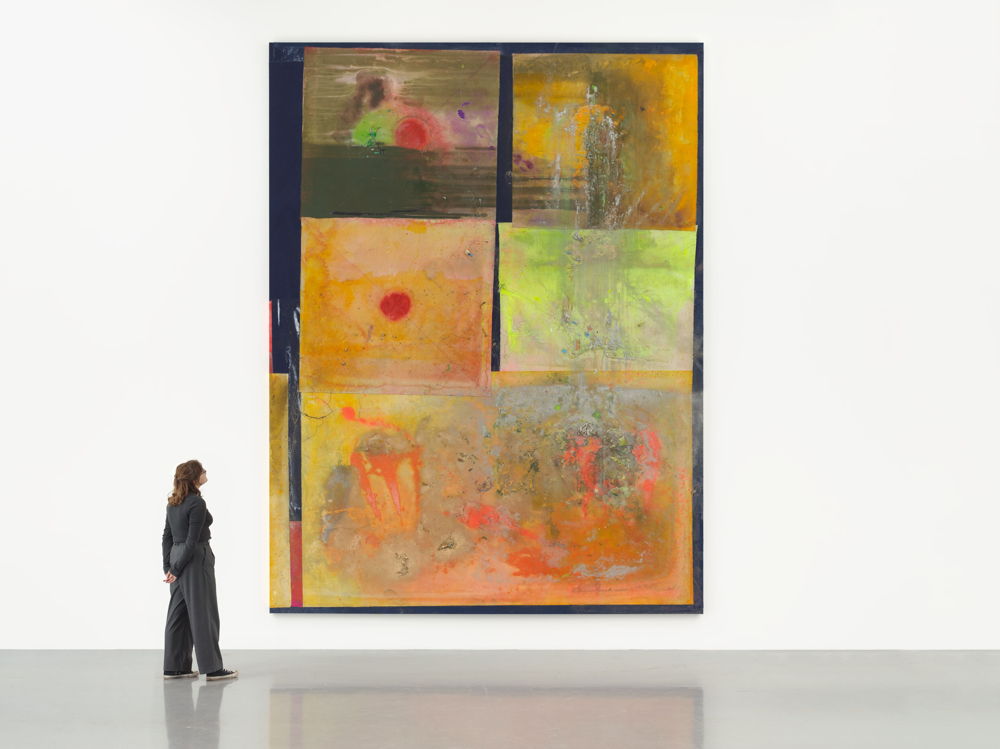Frank Bowling. Collage
Press Release

Hauser & Wirth Paris
22 March – 26 May 2025
‘Frank Bowling. Collage,’ the artist’s first solo exhibition in France, explores collage as a conceptual tool and technique for Bowling’s practice and thinking. The exhibition features works from the early 2000s up until the present day, where at the age of 90 he still paints on a daily basis. The starting point for the show is reflected in four new large-scale paintings on display in the ground floor gallery, which are comprised of multiple canvas panels. These monumental works—including the 4.4 meter-tall ‘Skid’ (2023)—are a renewal of Bowling’s use of collaged canvas and marouflage, which has long formed an important part of his practice. The exhibition is complemented by an academic program.
Bowling’s attraction to collage was partly influenced by Henri Matisse’s cut-outs, which he first encountered in the late 1950s and again at the 1992 MoMA retrospective in New York. For an article in the 1999 Winter issue of ‘Modern Painters,’ Bowling was asked to reflect on his career and select a work of art that most shaped or changed his own vision and chose ‘The Snail’ (1953) by Matisse. Paying homage to this work, Bowling has made several collaged pieces directly referencing the spiral pattern, including ‘Back to Snail’ (2000). Bowling’s first conceptual engagement with collage can be found in his early work in the ‘60s. Stating his material ambitions he has said, ‘I wanted to marry up all these disparate bits like color, mannerism, where you paint, this fandango of all these styles and make up a sort of strong work that has aspects of painting and sculpture and architecture […] they can hang together like something new.’
The works selected for this exhibition also evidence the development in Bowling’s incorporation of found objects. Since the 1980s, diverse materials have found their way into his paintings, from children’s toys to medical equipment. In ‘Skid,’ for example, there are pieces cut from a medical plastic bag, a protruding medical tube, loose canvas string and strips of canvas. These everyday objects provide the viewer with an entry point and most have some personal meaning to Bowling, acting as a form of autobiography. These items are embedded into the picture plane along with the translucent fluidity of acrylic gel and paint, breaking and erupting from the surface. ‘I’m moved to chuck in detritus, and watch it swim and settle,’ Bowling once said, ‘it makes me feel I can get to a whole vision of what I’ve passed through in life.’
About Frank Bowling
Sir Frank Bowling OBE RA has been hailed as one of the greatest living painters. Born in Guyana in 1934, Bowling arrived in London in 1953, graduating from the Royal College of Art with the silver medal for painting in 1962. By the early 1960s, he was recognized as an original force in London’s art scene with a style combining figurative, symbolic and abstract elements.
After moving to New York in 1966, Bowling’s commitment to modernism meant he was increasingly focused on material, process and color, so that by 1971 he had abandoned the use of figurative imagery. Bowling’s iconic ‘Map Paintings’ (1967-71), which include the stenciled landmasses of South America, Africa and Australia, embody his transition to pure abstraction. Bowling exhibited six large ‘Map Paintings’ in a solo show at the Whitney Museum of American Art in 1971. From 1973 to 1978, Bowling experimented with ideas of chance and ‘controlled accidents,’ pouring paint from a two-meter height to create his visually arresting ‘Poured Paintings.’
Bowling became a Royal Academician in 2005. He was awarded the OBE for Services to Art in 2008 and a knighthood in the Queen’s birthday honors in 2020. His work is represented in around 60 collections worldwide and has been exhibited in numerous group and solo exhibitions, including the 2017 – 2019 touring exhibition ‘Mappa Mundi,’ the hugely successful retrospective at Tate Britain in 2019 and the major exhibition ‘Frank Bowling: Americas,’ which toured from MFA Boston to SFMOMA in 2022 – 2023. In 2022, he was awarded the Wolfgang Hahn Prize which honors exceptional contemporary artists.
Today, Bowling’s mastery of the painted medium and explorations of light, color and geometry incorporate the use of ammonia and multilayered washes. His restless reinvention of the painted plane endures in his current bodies of work, which continue to break new ground through his use of thick impasto textures, acrylic gels, collage, stitched canvas and metallic and pearlescent pigments. Bowling works every day in his South London studio, forever driven by his fascination with exploring the vast and radiant possibilities of paint.
Press contacts:
Alice Haguenauer, Hauser & Wirth, alicehaguenauer@hauserwirth.com, +44 7880 421823
Adèle Godet, IC Insight Communications, adele@insightcommunications.cc, +33 7 82 26 21 61
Hauser & Wirth Paris
26 bis rue François 1er
75008 Paris
Gallery hours:
Tuesday to Saturday
10 am – 6 pm
Caption and courtesy:
All images:
© Frank Bowling. All Rights Reserved, DACS 2025
Courtesy the artist and Hauser & Wirth
Frank Bowling, Skid, 2023, Acrylic, acrylic gel and found objects on collaged canvas with marouflage, 442.4 x 336.5 x 5.4 cm / 174 1/8 x 132 1/2 x 2 1/8 in. Photo: Anna Arca
Sir Frank Bowling in his London Studio (2017). © Alastair Levy
Frank Bowling, Back to Snail, 2000, Acrylic, acrylic gel on canvas with marouflage, 40.7 x 34 x 4 cm / 16 x 13 3/8 x 1 5/8 in. Photo: Alex Delfanne
Frank Bowling, Water, 2024, Acrylic, acrylic gel and found objects on canvas with marouflage, 193.7 x 280 x 6.4 cm / 76 1/4 x 110 1/4 x 2 1/2 in. Photo: Alex Delfanne



